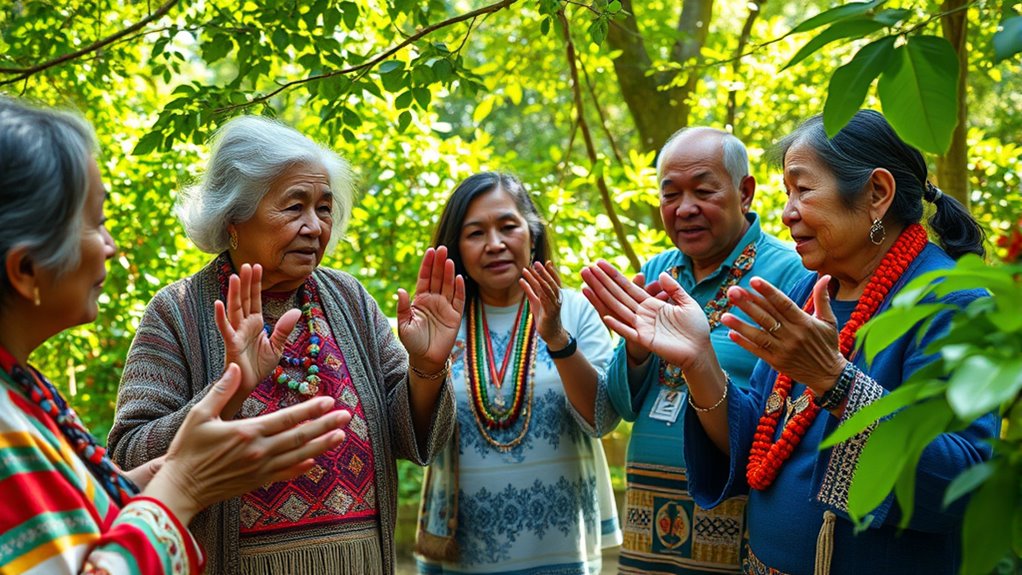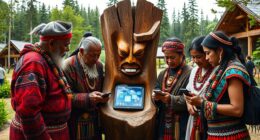Indigenous sign languages are powerful tools that go beyond spoken words, conveying stories, beliefs, and cultural traditions through visual gestures. They connect generations, preserve customs, and serve as symbols of community identity. These languages develop naturally within communities, reinforcing pride and cultural resilience. Communities and advocates work to document and support them, ensuring their survival. If you’re curious, you’ll discover how these visual languages showcase the richness and resilience of indigenous cultures worldwide.
Key Takeaways
- Indigenous sign languages serve as vital cultural tools that preserve traditions, stories, and community identity beyond spoken language.
- These visual languages develop organically within communities, reflecting local social structures and environmental contexts.
- Preservation efforts involve community-led initiatives, documentation, and resources to keep these languages alive for future generations.
- Indigenous sign languages act as symbols of cultural pride, fostering intergenerational connections and reinforcing collective belonging.
- Recognizing and supporting these languages highlights the diversity and resilience of indigenous cultures worldwide.

Have you ever wondered how indigenous communities communicate beyond spoken language? For many, sign languages are more than just gestures—they’re essential tools that carry deep cultural significance. These visual languages serve as a bridge connecting generations, preserving traditions, and maintaining a sense of identity that’s often threatened by external influences. In indigenous communities, sign languages aren’t just practical means of communication; they embody stories, beliefs, and histories that might otherwise be lost over time. They act as living repositories of cultural memory, guaranteeing that important customs and teachings are passed down visually, even if spoken words fade or become less common. This connection to tradition makes sign languages a powerful part of cultural preservation, helping communities retain their unique identities amid a rapidly changing world. Additionally, these languages often develop spontaneously within communities, reflecting their unique social structures and environmental contexts.
You might see these sign languages used in various contexts, from everyday conversations to ceremonial activities. They often develop organically within communities, shaped by shared experiences and cultural values. Because they’re deeply rooted in local customs, these languages reflect the worldview and social fabric of the community, making them more than simple communication tools—they’re expressions of cultural pride. This importance encourages younger generations to learn and keep them alive, reinforcing a collective sense of belonging. When you understand that these sign languages are intertwined with cultural identity, it becomes clear why efforts to document and revitalize them are so important. Without active preservation, many of these visual languages risk disappearing, taking with them centuries of wisdom, storytelling, and cultural nuance. Recognizing the cultural significance of these languages helps foster respect and support for their ongoing preservation.
The preservation of indigenous sign languages is often supported by community-led initiatives, linguists, and cultural advocates working together. They record gestures, develop teaching resources, and promote awareness of their importance. As a result, these languages gain recognition not just as communication methods but as essential symbols of indigenous heritage. You can appreciate that such efforts help ensure that future generations will continue to access and celebrate their cultural richness through visual language. Maintaining these sign languages also enhances intercultural understanding, showcasing the diversity and resilience of indigenous peoples worldwide. By valuing and supporting their language preservation, you contribute to a broader movement that recognizes the significance of indigenous cultures and their unique ways of expressing and sharing their stories beyond spoken words. Ultimately, indigenous sign languages stand as a tribute to human creativity, resilience, and the enduring power of cultural expression.
Frequently Asked Questions
How Do Indigenous Sign Languages Differ From Mainstream Sign Languages?
You’ll notice that indigenous sign languages differ from mainstream ones through dialectal variations and cultural significance. These languages are shaped by specific community traditions, beliefs, and environments, making them unique. Unlike standardized mainstream sign languages, indigenous signs often incorporate cultural symbols and gestures, reflecting their community’s identity. This deep connection to culture means that indigenous sign languages are essential for preserving heritage and fostering cultural pride among their users.
Are Indigenous Sign Languages Officially Recognized by Governments?
Did you know that only about 10% of indigenous sign languages have legal acknowledgment? You’ll find that many governments overlook their cultural significance, leaving these languages unrecognized officially. This lack of legal acknowledgment impacts their preservation and use. Recognizing indigenous sign languages is vital for respecting cultural diversity and ensuring communities can maintain their unique identities through their communication methods.
How Are Indigenous Sign Languages Being Preserved for Future Generations?
You can help preserve indigenous sign languages by supporting community involvement and educational programs. These initiatives teach the language to younger generations, ensuring its continuity. Participating in or funding community-led workshops and documenting the language also play essential roles. By actively engaging in these efforts, you contribute to safeguarding this rich cultural heritage, allowing future generations to connect with their identity and communicate beyond words effectively.
What Role Do Indigenous Sign Languages Play in Cultural Identity?
Indigenous sign languages play a essential role in your cultural identity by embodying cultural pride and preserving ancestral heritage. When you use these sign languages, you connect deeply with your community’s history and traditions, reinforcing your sense of belonging. They serve as a powerful reminder of your roots, allowing you to honor your ancestors’ ways of communication and keep their legacy alive for future generations.
How Can Outsiders Learn and Respect Indigenous Sign Languages?
Have you ever thought about how learning indigenous sign languages can bridge cultural gaps? To do so, you need to show cultural sensitivity and respect their traditions. Start by engaging with community members and supporting language documentation efforts. Are you willing to listen and learn, recognizing that mastering these languages isn’t just about words, but about honoring the people and their heritage? Your genuine effort fosters understanding and respect.
Conclusion
You witness the vibrant tapestry of indigenous sign languages, where gestures tell stories, connect communities, and preserve culture. You see the power of hands shaping identity, bridging gaps, and transcending silence. You feel the rhythm of tradition, the flow of expression, and the resilience of communication beyond words. You realize that these signs are more than gestures—they’re the heartbeat of heritage, the voice of history, and the future’s enduring language.
Mary is a passionate writer who brings creativity and a fresh perspective to our team. Her words have the power to captivate and inspire, making her an essential contributor to our content. Mary’s commitment to storytelling and dedication to promoting Indigenous culture ensures that her work touches the hearts of our readers. We’re fortunate to have her as part of our team.










